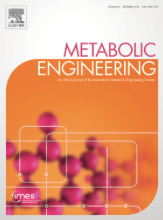| Title | Fast growth phenotype of E. coli K-12 from adaptive laboratory evolution does not require intracellular flux rewiring. |
| Year of Publication | 2017 |
| Authors | C.P. Long; J.E. Gonzalez; A.M. Feist; B.O. Palsson; M.R. Antoniewicz |
| Journal | PLoS Comput Biol |
| Abstract | Adaptive laboratory evolution (ALE) is a widely-used method for improving the fitness of microorganisms in selected environmental conditions. It has been applied previously to Escherichia coli K-12 MG1655 during aerobic exponential growth on glucose minimal media, a frequently used model organism and growth condition, to probe the limits of E. coli growth rate and gain insights into fast growth phenotypes. Previous studies have described up to 1.6-fold increases in growth rate following ALE, and have identified key causal genetic mutations and changes in transcriptional patterns. Here, we report for the first time intracellular metabolic fluxes for six such adaptively evolved strains, as determined by high-resolution (13)C-metabolic flux analysis. Interestingly, we found that intracellular metabolic pathway usage changed very little following adaptive evolution. Instead, at the level of central carbon metabolism the faster growth was facilitated by proportional increases in glucose uptake and all intracellular rates. Of the six evolved strains studied here, only one strain showed a small degree of flux rewiring, and this was also the strain with unique genetic mutations. A comparison of fluxes with two other wild-type (unevolved) E. coli strains, BW25113 and BL21, showed that inter-strain differences are greater than differences between the parental and evolved strains. Principal component analysis highlighted that nearly all flux differences (95%) between the nine strains were captured by only two principal components. The distance between measured and flux balance analysis predicted fluxes was also investigated. It suggested a relatively wide range of similar stoichiometric optima, which opens new questions about the path-dependency of adaptive evolution. |
| PubMed ID | 28951266 |
